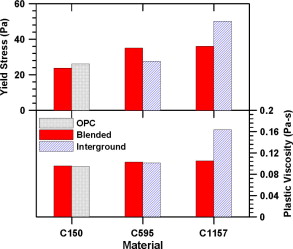Citation
Vance, K.; Arora, A.; Sant, G.; Neithalath, N. Construction and Building Materials 2015, 79, 65-72.
Vance, K.; Arora, A.; Sant, G.; Neithalath, N. Construction and Building Materials 2015, 79, 65-72.
This paper reports a comparative study of the rheological properties of suspensions composed using ordinary portland cement (OPC), interground with, and blended with limestone. Two different interground portland limestone cements (PLCs) and three blended limestone cements were examined. The blended mixtures were prepared using the same limestone content (by replacement) as the interground mixture, and blended to match the particle size distribution (PSD) of the plain OPC and interground PLCs. This methodology was used to separate the influence of packing and surface area from the influence of the limestone incorporation technique (i.e., intergrinding or blending). The results indicate that the inclusion of limestone decreases the yield stress due to reduced van der Waals forces between limestone-to-OPC particles, as compared to OPC-to-OPC particle interactions. The plastic viscosity is noted to be independent of the limestone replacement level, and dependent solely on the volumetric solid loading and PSD of the solids in the suspension. Intergrinding of limestone is shown to have beneficial effects on the yield stress compared to PSD-matched OPC–limestone blends, due to coarser OPC fraction in the interground PLC as compared to the blended mixture. Finally, via oscillatory shear experiments, the use of a stress plateau identification technique is demonstrated to be an accurate means to identify the yield stress in cementitious suspensions all suspensions.
